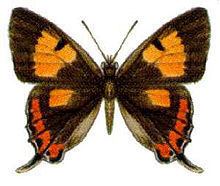Scientific name Pseudalmenus chlorinda Rank Subspecies | Subfamily Theclinae Order Butterflies and moths | |
 | ||
Genus PseudalmenusDruce, 1902 Similar Butterflies and moths, Jalmenus icilius, Hypochrysops byzos, Jalmenus, Ogyris abrota | ||
The silky hairstreak (Pseudalmenus chlorinda), also known as the chlorinda hairstreak, is a butterfly belonging to the family Lycaenidae. It occurs in Australia. It is the only species in the monotypic genus Pseudalmenus.
Contents
Taxonomy
The silky hairstreak was first described by Emile Blanchard in 1848. Subspecies include:
Description
The adult silky hairstreak has a wingspan of 28 mm. The male and female are similar, with the wings of the female slightly more rounded. The wings are black or brown on top with yellow-orange patches. The lower wings have orange patches and black tails with white edges. The underside of the wings is yellow grey with black and orange markings. The eggs are pale green with a diameter about 1 mm. They are usually laid in small groups on the twigs of a food plant.
The caterpillars grow to a length of around 3 cm. They have a black head and a brown, red, black and yellow body. The larvae of the silky hairstreak secrete substances that attract Anonychomyrma biconvexa ants.
Distribution and habitat
It is found in south-eastern Australia including New South Wales, Victoria and Tasmania. The species only occurs where the attendant ant species is found, and the larval food plant grows.
The caterpillars feed on various Acacia species including the A. dealbata, A. decurrens, A. elata, A. mearnsii, A. melanoxylon, A. obtusata, A. pravissima, A. terminalis and the A. trachyphloia.
